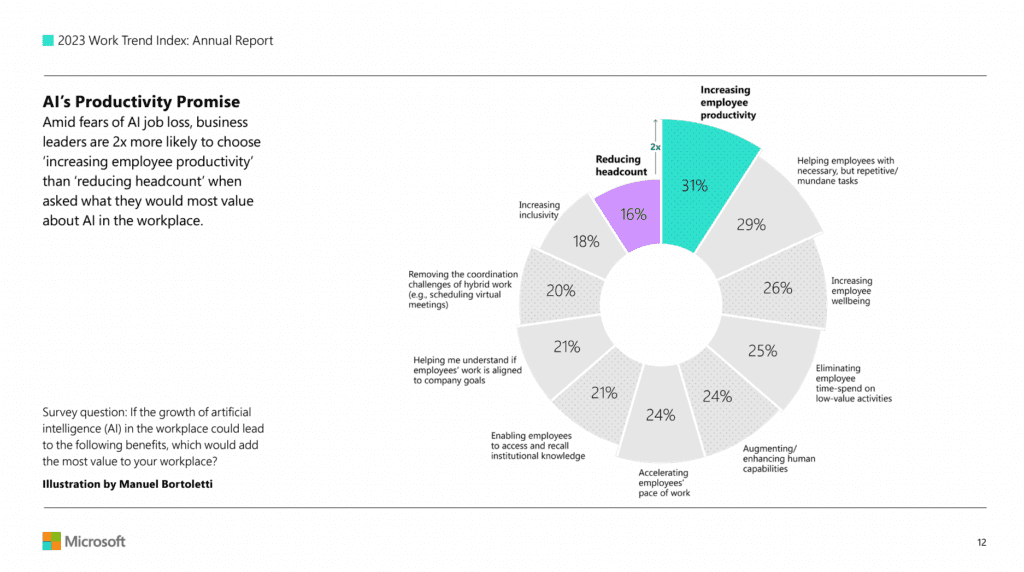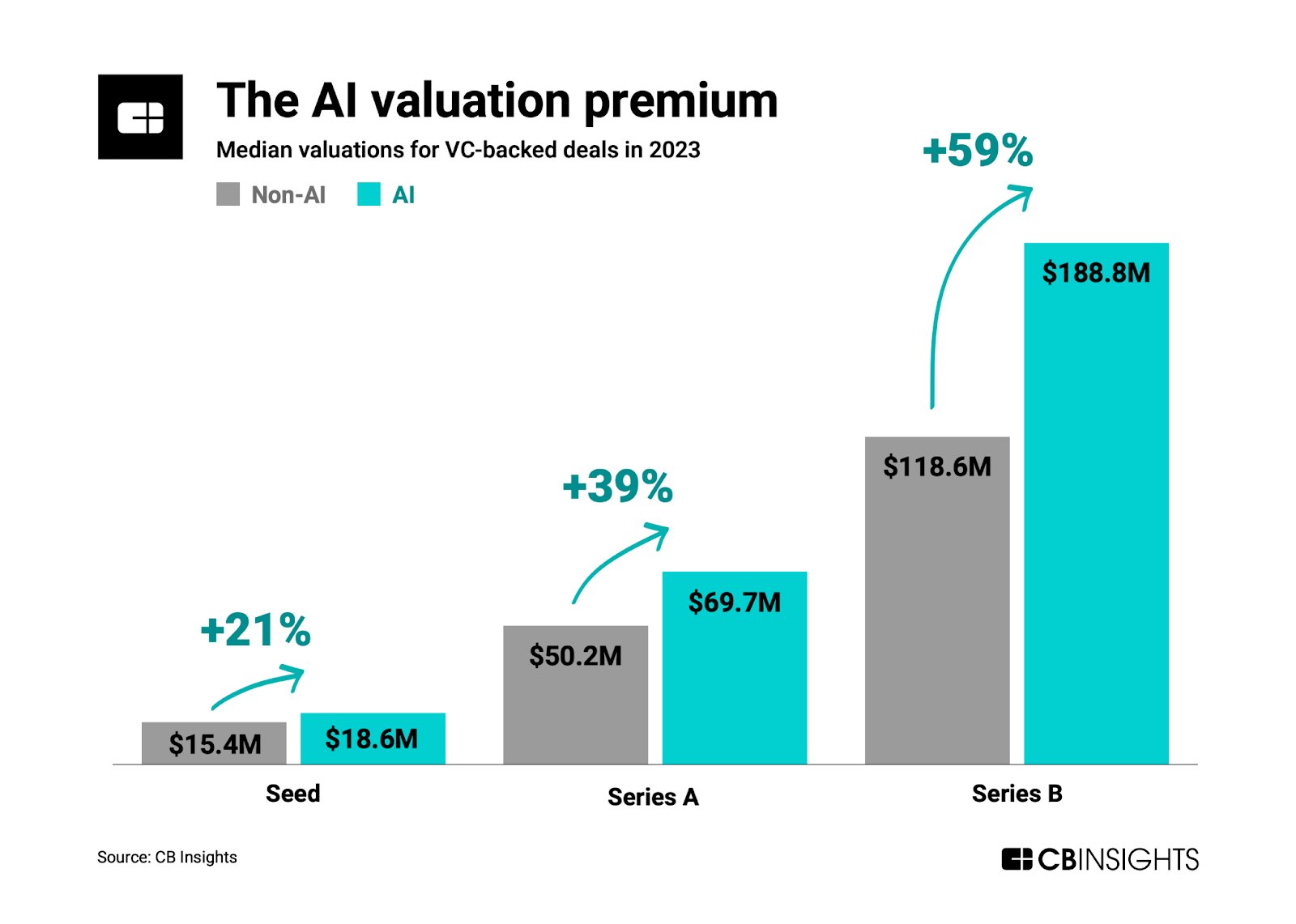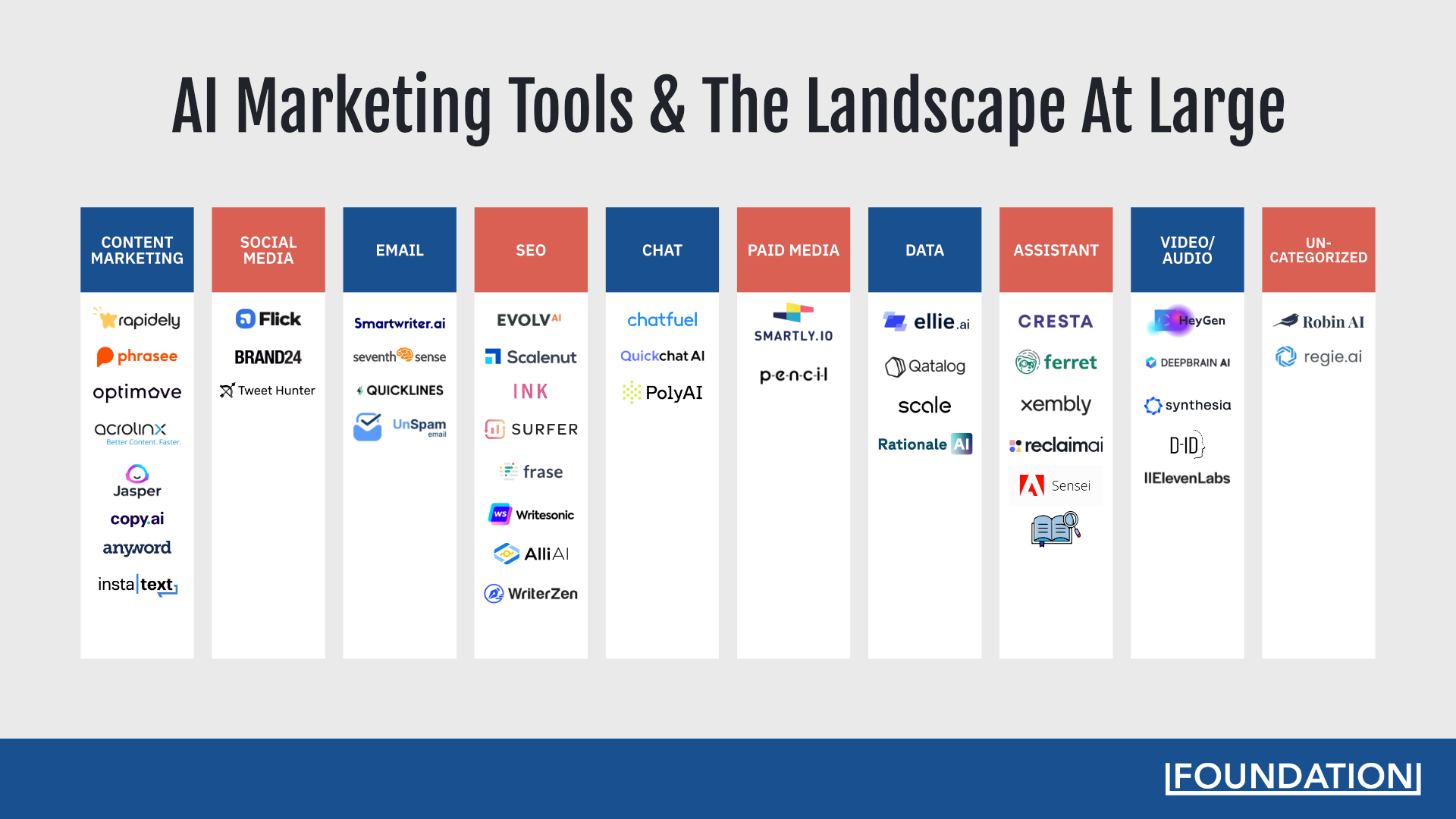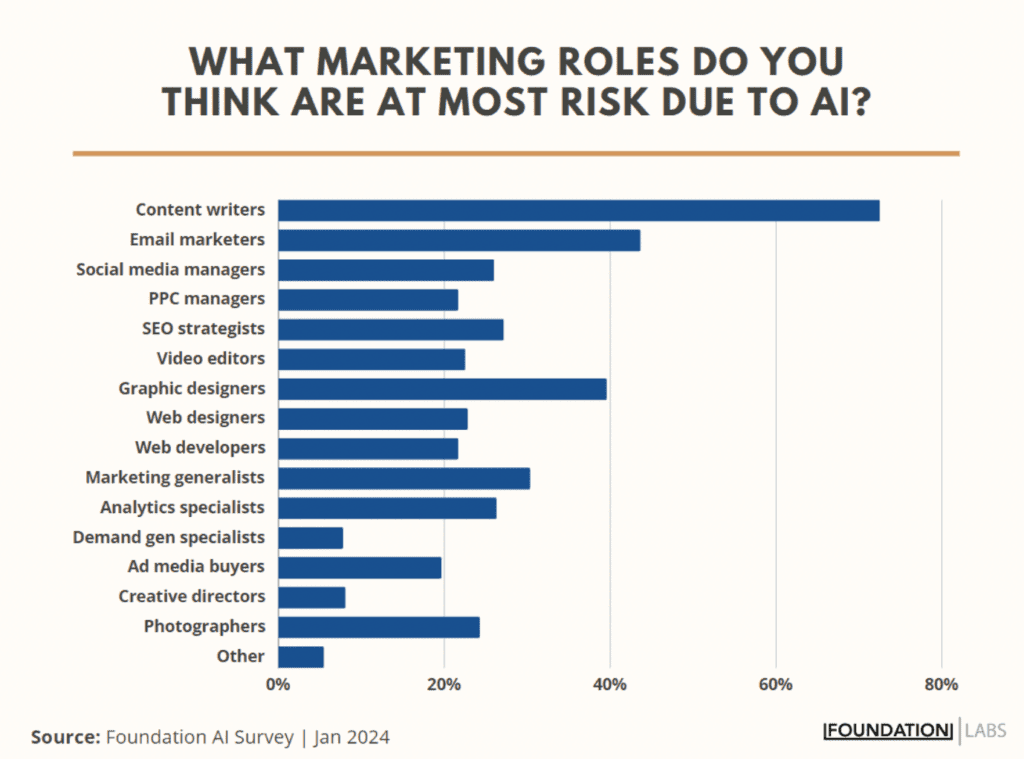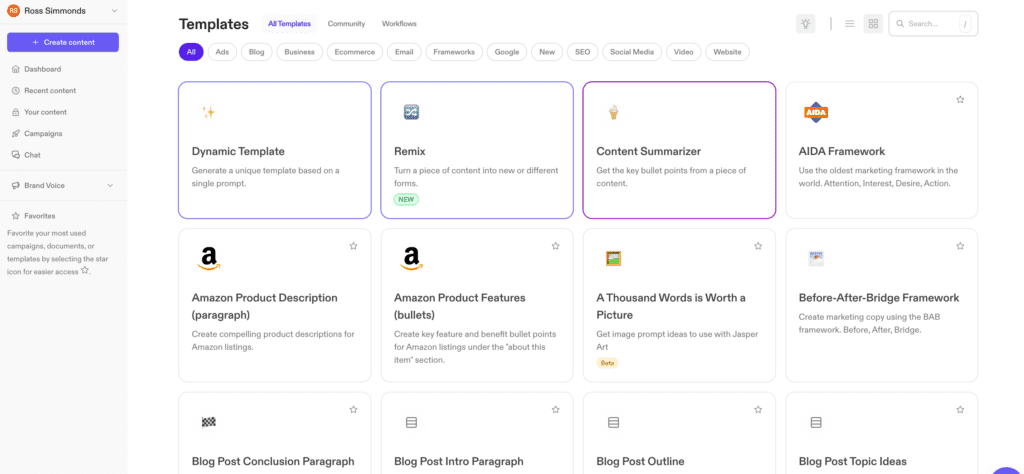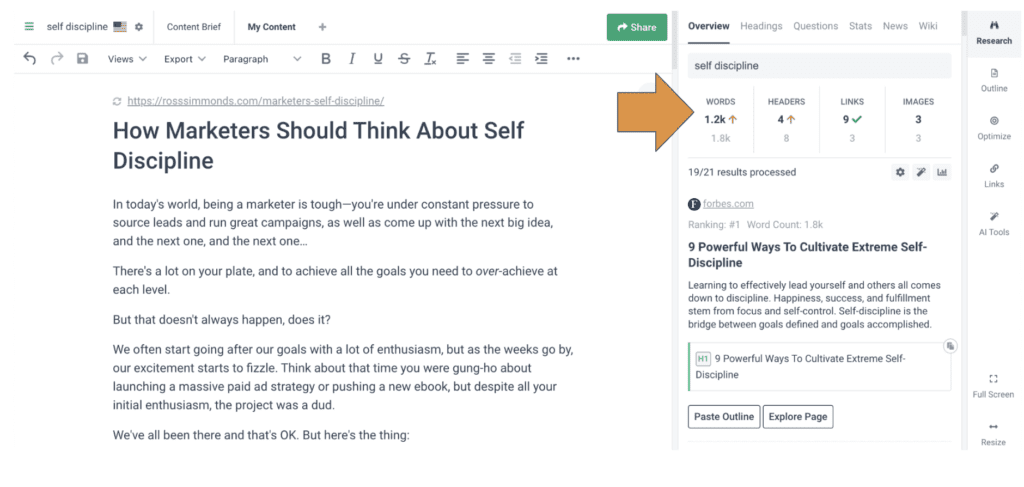Have you ever felt challenged by the constant need to update content?
AI can do it now.
Have you ever struggled to find the perfect stock photo?
AI can do it now.
Have you ever dreaded the process of editing a podcast?
AI can do it now.
Artificial Intelligence has revolutionized marketing.
AI-powered tools can analyze data, create content and deliver insights that enable all of us to do more in the matter of minutes what at one point would take hours.
Automated content generation, AI powered customer segmentation, and AI driven lead scoring are just some of the many tasks that AI has streamlined for me as a CEO and marketer. AI has freed many of us up to focus on creative, higher value tasks and strategic thinking.
This change is real.
This change is impactful.
And the impact of AI is going to continue to influence the industry for years to come.
But what is Generative AI exactly? Let’s dive into it…
What Is Generative AI?
Generative AI is a subset of artificial intelligence that leverages machine learning techniques to produce content. It’s like giving AI the ability to be creative, to generate something new. From writing complete sentences, creating artwork, composing music, to even generating code, Generative AI can mimic and enhance human creativity.
Generative AI works by training an AI model with a large dataset in a particular domain (such as text, images, music, etc.) and then allowing the AI to generate similar, original content. This is achieved through the utilization of advanced models like Generative Adversarial Networks (GANs), which consist of two parts: a “generator”, which creates new content, and a “discriminator”, which evaluates the generated content against the original dataset.
The AI learns and improves over time, making its creations increasingly more realistic and refined. One of my favorite resources (yes, I’m biased) on Generative AI is this LinkedIn Learning course that helps marketers better understand how to use Generative AI in the form of ChatGPT to execute at a high level on the back of these resources.
What Is Artificial Intelligence then?
Artificial Intelligence (AI), at its core, is the science of training machines to mimic human intelligence. This is achieved through creating algorithms that allow computers to interpret data, learn from it, make predictions, or take actions to complete a specific task. These tasks can range from simple ones like recognizing patterns or sorting data to more complex ones like interpreting human speech, diagnosing diseases, or driving cars.
AI is broadly categorized into two subsets: Narrow AI and General AI.
Narrow AI, also known as Weak AI, is designed to perform a narrow task such as voice recognition or driving a car. This type of AI operates under a limited set of constraints and is focused on a single narrow task.
It’s the kind of AI that we see embedded in our smartphones, smart home devices, or even in the automated customer service chatbots. While these systems can perform tasks that would normally require human intelligence, they operate under a very limited and predefined set of constraints and can’t deal with a task they weren’t specifically programmed for.
On the other hand, General AI, also known as Strong AI, refers to systems or devices which can handle any intellectual task that a human being can do.
They can understand, learn, adapt, and implement knowledge from one domain to a new, unfamiliar one. While this is the kind of AI that we see in sci-fi movies, as of now, it remains largely theoretical and is the ultimate goal of many AI researchers.
In between these two lies Generative AI, that we discussed earlier, which represents a significant advancement in the field, bridging the gap between Narrow and General AI. Generative AI allows machines not just to understand and interpret data, but to create and generate new content, be it text, image or even music.
How Will Generative AI Impact Marketers
Thirty-one percent of workers in a recent Microsoft survey indicated that they believe AI has the ability to increase employee productivity. In the same survey, sixteen percent of respondents shared fear of AI job loss while sharing that this reduction in workforce / headcount would be a value add to the workplace.
Here’s the slide from the Work Trend Index Annual Report, published by Microsoft:
This could be viewed positively or negatively depending on how you look at it.
Everything is going to change.
The processes that were once held so dear and near to our heart are up for grabs.
The tasks that we thought were our own special sauce are now up for grabs.
And sadly…
In some cases, the jobs that put food on our tables are also now up for grabs.
AI is going to fundamentally change the way that this industry operates and we’re in the early days.
The total valuation of AI startups according to CB Insights was more than 21% higher for seed stage, 39% higher for Series A and 59% higher for Series B startups. The higher valuations of these AI related technologies demonstrate a clear indication of where some of the most innovative investors think the future lies.
Here’s a comparison of non-AI vs. AI powered startups:
The valuation spike isn’t the only thing on the rise.
One of the biggest indicators that AI is changing the way work is done is the frequency in which the dialogs around Generative AI are happening on the Earning Calls of Publicly Traded companies on the stock market. This is a valuable data point because it helps us get a glimpse into what is happening within different organizations.
According to Wall Street Zen, the number of AI mentions in earnings calls during the second quarter of 2023 had increased by 366 percent compared to the prior quarter year over year.
But it doesn’t end there.
The rise of Generative AI continues to shake up the industry by showing up in marketing tools.
For marketers the number of AI related tools on the market is greater than ever before.
Here’s a snapshot of just a few of the many AI tools that currently make up the market at large:
The rise of AI Marketing Tools is a great thing for marketers. It’s allowing marketers to do more things that were impossible before. Here’s a few things that these AI tools are allowing marketers to do:
- Create content at scale
- Manage social media channels with ease
- Create personalized content in real time
- Replace stock photos with interesting assets
- Create graphics that are personalized and custom
- Use AI to develop audio assets that are unique
- Create scalable content for paid media campaigns
- And so much more…
The global artificial intelligence market size was estimated at USD 136.6 billion in 2022 and is expected to reach USD 196.6 billion in 2023. According to Bloomberg, it’s estimated to be a $1.3T industry by 2032.
That’s a lot of opportunity.
In a recent interview with the team at MarketerHire, I shared some predictions and insights around how Artificial Intelligence would be a driving influence in marketing for the next few years. In this interview, we dive into long form content creation, Deep Fakes, Video AI and more. It’s a fascinating dialog and one that I think a lot of marketers would benefit from seeing:
Overall, the role of generative AI in marketing content creation cannot be overstated.
It streamlines the creation process.
It streamlines the distribution process.
And it streamlines the optimization process.
Whether it’s improving the way we run PPC campaigns or creating images at scale to run better campaigns — the power of AI for marketers is significant.
Overall, the role of generative AI in marketing content creation cannot be overstated. It streamlines the content generation process while providing marketers with valuable insights to enhance creativity and engagement levels.
Here are a few of the best use cases for AI as a marketer:
Use Case: Brainstorming And Idea Generation
AI can be an incredibly powerful tool for brainstorming and idea generation. By harnessing the power of machine learning algorithms, marketers can tap into a vast reservoir of data to generate fresh, innovative ideas.
For instance, AI tools can analyze historical data, user behavior patterns and market trends to provide content suggestions that resonate with the target audience. You can also ask ChatGPT to do a bit of research on your audience and use that to guide your brainstorming exervise.
Here’s one of my favorite prompts for ChatGPT:
You’re a digital marketing expert who has studied the power of creating data-driven content campaigns to drive results for brands. You understand the idea of Digital PR and are great at identifying story ideas that will get press. You work for [BRAND] and need to come up with XX ideas for research studies that can be conducted to get links from the media. Identify these ideas and make them very unique, data driven and interesting.
AI thrives on prompts like this.
The more specific the prompt – the better the result. I’ve created an entire swipe file with over 130 prompts and 20 walk through videos sharing prompts like this one. It’s called the AI Marketing Console and is a guide to using AI the right way as a marketer.
Use Case: Automating Content Creation
Artificial Intelligence has been a game-changer for content creation.
In a recent study conducted by Foundation, the vast majority of marketers shared that they believe content creators are at the most significant risk of losing their jobs due to AI:
Right at the top of the list stand content writers.
This is scary for many.
Over 70% of marketers think that content writers are at risk of losing their job to artificial intelligence. In the same survey, these marketers shared that while they believe content writers are at risk – they acknowledge that human writers are still able to develop content in a way that is still better than what an AI can develop:
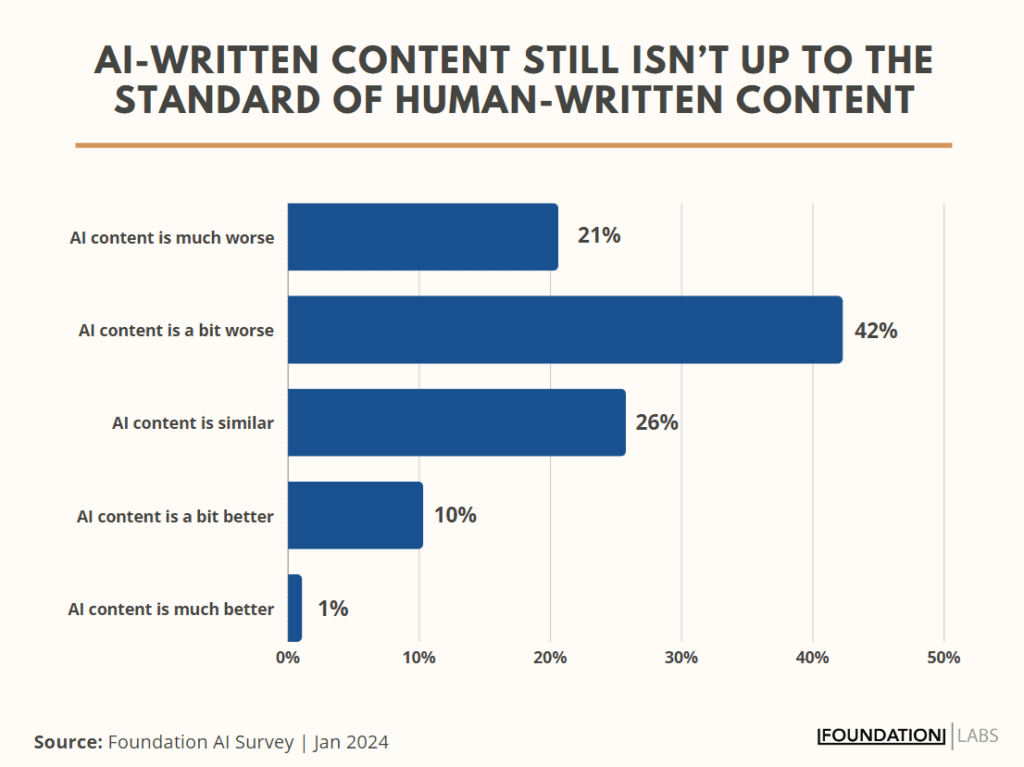
AI can be used to write blog posts through several methods. First off, it can generate ideas for blog posts from a simple prompt. Using machine learning algorithms, AI can analyze past data and trends to come up with intriguing topic suggestions that resonate with your audience.
One of the leaders in the AI market is Jasper.AI which is a Content Marketing AI tool that offers a wide range of templates for marketers to select and use to create content. The template include everything from Ads and Blogs to Emails & Website content.
Here’s a look at what their dashboard looks like when you’re using their AI tool to create content:
One of my favorite features of Jasper is their Chrome Extension which allows you to use AI directly in Google docs.
If you’re interested in learning more about Jasper check it out here.
Use Case: Enhancing Existing Content
One of my favorite use cases of AI is leveraging tools like Frase.
If you’re not familiar with Frase, it’s an AI tool that allows you to upload a URL from your website along with the target keyword. Upon analyzing the blog post that you have already published, it will cross reference the content you have created with the content that is in the SERP and make a recommendation to you around how you can optimize that piece.
For example, in the image below it’s suggesting we increase the number of words and headers in a blog post that I wrote on the idea of self discipline:
The amount of time that it once took for marketers to do this work is evaporated.
This typically took hours and can now be done in less than 5 minutes. That’s the power of artificial intelligence.
Use Case: Create Compelling Visuals
Dall-E and Midjourney are two of the front runners in AI visualization.
These tools give marketers the ability to cut out the need for stock photo sites and get almost any image they can imagine.
For example, if I wanted Midjourney to turn me into Willy Wonka, I can simply upload a photo of myself and ask it to put me in a Willy Wonka scene and in the matter of minutes… Here’s the result:
I don’t think it looks like me.
But I do think it’s pretty good.
What To Keep In Mind Using Generative AI?
AI can change the way you run your marketing initiatives. It’s a technology that is changing the way marketing is done the same way that social media did many years ago. If you’re going to embrace AI — there are a few things to keep in mind that are important before you go all the way in and embrace the technology.
- Understand that AI comes with bias. Not every AI tool is trained on the most diverse set of opinions, ideas or content. As such, it’s possible that the results that you get back from an AI are biased.
- Understand that sometimes an AI will hallucinate. It’s not unlikely to ask AI a question and AI turns around and makes a few things up.
- Understand that there are limitations to AI. Although AI can mimic human creativity, it still has its limitations and cannot replace the depth of emotion and understanding that humans have.
- Always have a human in the loop. Whether it’s reviewing and editing AI-generated content or making final decisions on strategies based on AI’s insights, it’s crucial to have a human involved in the process.
- Keep track of the data. AI relies heavily on data, so it’s essential to keep track of the input and output data in order to understand and improve its performance.
By keeping these points in mind, marketers can effectively integrate Generative AI into their strategies while also considering potential challenges that may arise. With proper understanding and usage, Generative AI has the potential to transform how marketers work. I’m confident in that.
There’s no question that AI still has limitations. But there’s also no question that it can be used to elevate your content workflows and improve your approach at large.

